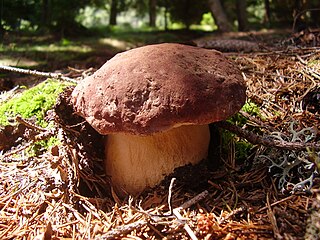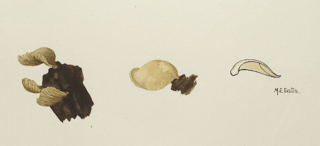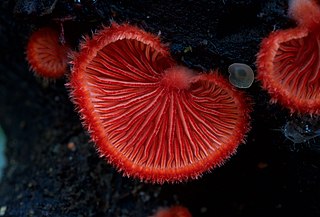
The genus Phallus, commonly known as stinkhorns, is a group of basidiomycetes which produce a phallic, often foul-scented mushroom, from which their name is derived. The genus has a widespread distribution and, according to a 2008 estimate, contains 18 species. They belong to the family Phallaceae in the order Phallales. The best known species is the common stinkhorn.

Orson Knapp Miller Jr. was an American mycologist. He published numerous papers in mycology and was responsible for the naming of many taxa, as well as being one of the authors erecting the genus Chroogomphus. He described Omphalotus olivascens, several species of Amanita, and the ghoul fungus Hebeloma aminophilum.

Boletus pinophilus, commonly known as the pine bolete or pinewood king bolete, is a basidiomycete fungus of the genus Boletus found throughout Europe and western Asia. Described by Italian naturalist Carlo Vittadini in 1835, B. pinophilus was for many years considered a subspecies or form of the porcini mushroom B. edulis before genetic studies confirmed its distinct status. In 2008, B. pinophilus in western North America were reclassified as a new species, B. rex-veris. B. pinophilus is edible, and may be preserved and cooked.

Crepidotus is a genus of fungi in the family Crepidotaceae. Species of Crepidotus all have small, convex to fan-shaped sessile caps and grow on wood or plant debris. The genus has been studied extensively, and monographs of the North American, European, and Neotropical species have been published.

Crepidotus versutus, commonly known as the evasive agaric, is a species of fungus in the family Crepidotaceae. It is saprobic on wood, like other Crepidotus species, but it can also decompose herbaceous forest litter. The species is characterized by large, punctate, ellipsoid spores, and the white, hairy pileus.

Pisolithus is a genus of fungi within the family Sclerodermataceae.

Suillus lakei, commonly known as the matte Jack, Lake's bolete, or the western painted Suillus, is a species of fungus in the family Suillaceae. It is characterized by the distinctive reddish-brown tufted fibers or small scales on the cap, and the presence of a woolly veil on the stem. The caps can reach diameters of up to 15 cm, while the stems are between 6 and 12 cm long and usually 1–3 cm thick. On the underside of the cap is a layer of spongy yellow to yellow-brown angular pores; these pores are covered with a whitish partial veil when young. A mycorrhizal fungus, S. lakei grows in association with Douglas fir, and is found where this tree occurs. It is native to northwestern North America, but has been introduced to Europe, South America, and New Zealand. The mushroom is edible, but opinions vary considerably as to its quality.

Clavariadelphus ligula, commonly known as the strap coral, is a species of fungus in the family Gomphaceae. It produces club-shaped fruit bodies with spongy flesh that grow in groups on the forest floor. It is found in Asia, Europe, and North America.

Guepinia is a genus of fungus in the Auriculariales order. It is a monotypic genus, containing the single species Guepinia helvelloides, commonly known as the apricot jelly. The fungus produces salmon-pink, ear-shaped, gelatinous fruit bodies that grow solitarily or in small tufted groups on soil, usually associated with buried rotting wood. The fruit bodies are up to 10 cm (4 in) tall and up to 17 cm wide; the stalks are not well-differentiated from the cap. It has a white spore deposit, and the oblong to ellipsoid spores measure 9–11 by 5–6 micrometers.

Phyllotopsis nidulans, commonly known as the mock oyster or the orange oyster, is a species of fungus in the family Phyllotopsidaceae, and the type species of the genus Phyllotopsis. It is widely dispersed in temperate zones of the Northern Hemisphere, where it grows on decaying wood. The fungus fruit body consists of a fan-shaped, light orange fuzzy cap up to 8 cm (3 in) wide that grows singly or in overlapping clusters. On the cap underside are crowded orange gills. Mock oyster mushrooms have a strong, unpleasant odor, and are regarded as inedible though nonpoisonous.
Aurel Dermek was a Slovak mycologist, writer, photographer and illustrator.

Leccinum holopus, commonly known as the white birch bolete, white bog bolete, or ghost bolete, is a species of bolete fungus in the family Boletaceae found in northern Asia, Europe, and northeastern North America. It associates with birch trees and is typically found in boggy or swampy areas, often growing among sphagnum moss.
Hygrophoropsis fuscosquamula is a species of fungus in the family Hygrophoropsidaceae. Found in Europe, it was described as new to science by English mycologist Peter Darbishire Orton in 1960. Fruit bodies of the fungus have whitish cream to pale yellowish caps with many small, olive-brown scales. Its spores measure 6.0–8.0 by 3.5–4.5 μm.

Crepidotus epibryus, is a species of saprophytic fungi in the family Crepidotaceae. It is commonly known as grass oysterling in the United Kingdom and is seen there in late summer and autumn.

Crepidotus affinis is a species of saprophytic fungus in the family Crepidotaceae with a stipeless sessile cap. The fungus was described by Egon Horak in 2018 and has been found in New Zealand, Panama, and the Philippines.

Crepidotus albescens is a species of saprophytic fungus in the family Crepidotaceae with a stipeless sessile cap.

Crepidotus albolanatus, is a species of saprophytic fungus in the family Crepidotaceae with a stipeless sessile finely felted cap. Colour is pure white, cap diameter 10–35 mm and has been found in New Zealand on the debris of the nikau palm.

Crepidotus brunnescens, is a species of saprophytic fungus in the family Crepidotaceae with a stipeless sessile cap which is smooth and yellowish-brown. It is often found on hardwood logs such as Quercus.

Crepidotus cinnabarinus is a species of saprophytic fungus in the family Crepidotaceae with a stipeless sessile cap distributed in North America and Europe. It is highly conspicuous and often found on fallen branches and rotting trunks of broad leafed trees. In England it appears from late summer to autumn.

















